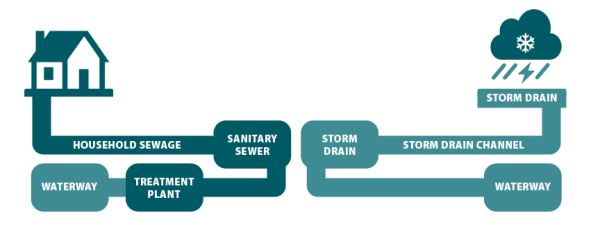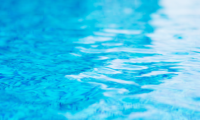Residential Hot Tub and Pool Drainage Guidelines
Did you know? Draining your swimming pool or hot tub into your backyard or a storm drain could be harming your local environment. Squamish is an intricate web of streams, rivers and wetlands that flow into the estuary and Howe Sound.
Chemicals used to keep pools and hot tubs disinfected are toxic to fish, amphibians and other aquatic organisms that live in these waterbodies. Toxic pool chemicals include chlorine, bromine, salt, copper-based algaecides and nonylphenols (used in many cleaning agents and personal hygiene items). Chlorine is particularly harmful to aquatic environments even in very low concentrations.
It is not appropriate to drain salt water onto your lawn as the salt levels often kill grass and will remain in the soil. Saltwater pools can only be drained to a sanitary sewer (see Option 2) or hauled to a wastewater disposal site (see Option 3). Download the brochure.
DO NOT drain pools into storm drains or waterbodies. Storm drains are often directly connected to nearby creeks and rivers.

Storm drains can be recognized by open grates along roads or in ditches.
3 Ways to Responsibly Drain your Pool/Hot Tub:
Option 1 - Drain pool or hot tub water onto your lawn. Water can be drained onto your lawn if it remains on your property.
- DO NOT drain salt water onto your lawn, see Option 2 or 3.
- REDUCE chlorine and other chemical levels by holding water in pool/hot tub for up to two weeks to allow dissipation, or purchase a dichlorination kit.
- NOTIFY the District of discharge location and date with an email to environment@squamish.ca.
- Drain water to a FLAT and DRY AREA.
- Discharge at a LOW FLOW RATE to avoid pooling, erosion and potential runoff from the property.
- DO NOT proceed if draining could result in runoff from your property, or within 30 metres of a watercourse (ditch, stream, storm sewer, or riparian area) and utilize Option 2.
- STOP draining if rainfall causes increased pooling and/or drainage off the property.
Option 2 - Discharge pool or hot tub into the District’s sanitary sewer system or a private septic system.
The sanitary sewer system sends the water to the District’s wastewater treatment facility. This option is acceptable for both chlorinated and salt water.
- NOTIFY the District of discharge location and date at 604. 815. 6868 or email
publicworks@squamish.ca. - TEST water for contaminant levels (chlorine, pH) before discharge into the sanitary sewer system. A list of acceptable limits can be found in Schedule B in the District of Squamish Sewer Use Bylaw 2474, 2016.
- Chlorine less than or equal to 5.0 mg/L pH between 5.5 and 12.5
- Phenols less than or equal to 1.0 mg/L
- USE appropriate equipment to drain water into private plumbing fixtures connected to the District’s sanitary sewer system. If unsure how to do so, contact a licensed plumber.
- WATCH draining activities and be ready to call a plumber if a sewer backup occurs.
- ONLY discharge water to a private septic system at a rate appropriate for what the septic system is designed for. If unsure, contact a registered on-site septic system professional.
Option 3 - Haul water to an approved disposal facility or call a vacuum truck service provider.
This option is acceptable for both chlorinated and salt water. If Option 1 and 2 are not feasible, water can be removed via the following:
- HAUL wastewater to the Waste Water Treatment Plant. Private sanitary sewer fees can be found in the Fees and Charges Bylaw No. 2012, 2017.
- CALL a professional to remove wastewater, such as a vacuum truck service provider.
Contact us
Please contact us if you have any questions or concerns before draining your pool or hot tub.
604.892.5217 or by email
As per the District of Squamish Sewer Use Bylaw 2474, 2016 improper discharge of contaminated water can result in a minimum fine of $1,000. Visit the bylaw library to view the bylaws.

